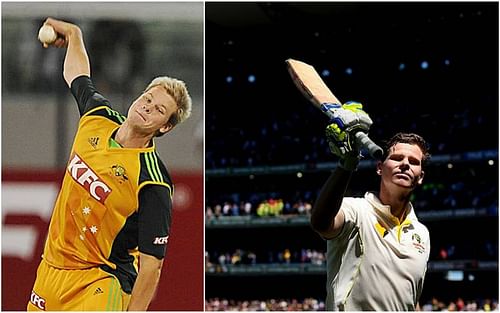
Steven Smith - From spin option to No.1 Test Batsman

Steven Smith was never meant to be Australia’s No.3, a position that had been occupied by Ricky Ponting for such a long time. Most opponents hardly celebrated when they picked the first wicket in a Test against Australia as that would bring the great man to the crease.
Steven Smith, who tasted fame and recognition as part of the U-19 team, was meant to be a leg-spinner. Funny as it may seem, it took Australia more than a few years to come to terms with the fact that Shane Warne was gone and that his boots would be too big to fill. Smith was one of those who was put to the task.
He was a handy leg-spinner, but he was not cut out for it – far from it in fact. He did play a series against Pakistan as Australia’s No.1 spinner and didn’t do so well in the limited opportunities he received. Those were turbulent times in Australian cricket – a rare six-year patch when they went without winning the Ashes.
From the bottom
Smith was inducted into the team as a bowler against Pakistan, at Lord’s. There were glimpses of his batting talent, but it took a while before those were paid attention to. He was part of Australia’s losing Ashes campaigns, including one of their worst nightmares when they lost 1-3 at home against England.
In spite of some decent starts, Smith couldn’t find a place in the Test side for a couple of years. It was almost as if it was hard to see him as a permanent No.6 even though he got runs. He was not elegant. He was not a pretty batsman. He didn’t have Ponting’s audacity or Michael Clarke’s finesse. He didn’t have Michael Hussey’s technique. He just didn’t fit in Australia’s road to recovery.
Homework-gate
One of the most infamous coach-player feuds took place in the midst of one of Australia’s worst Test campaigns in their cricket history. They lost 0-4 to India in India. During that period though, four of Australia’s top players were suspended by their team management because they didn’t do their “homework”.
That gave Smith an opportunity against what would become his most beloved opponent. He grabbed it with both hands scoring a wonderful 92 at Mohali. The rest, as they say is history, even though it unravelled in a considerably short time.
Downpour of accomplishments
Steven Smith was part of the Australian team that beat England 5-0 to regain the urn after a long time. His first three Test centuries came against England. His fourth came in a win in South Africa. The next four, came at home, against India, where Smith achieved many feats including hitting a century in each Test of a series, registering the third highest tally of runs in four matches of a series and becoming the first Australian skipper to score centuries in his first three Test matches as captain.
Another 199 came in West Indies, helping Smith become the second youngest player ever to reach the ICC No.1 ranking for batsmen.
Amidst the Test glory, where Smith is heir apparent to captain Michael Clarke, there was also the small matter of the World Cup win. Smith played two crucial knocks, in the quarter-final against Pakistan and then in the semi-final against India, where he scored a ton. It was a phase when Smith could do no wrong.
He is still enjoying the enormous thrills and frills of that phase that has now extended for a little too long for it to be called fortuitous or accidental. He is world-class and at 26 years, is probably the best amongst the generation of cricketers who will go on to become future legends, along with Kane Williamson, Virat Kohli, and Joe Root.
Temperament and technique for all formats
Smith is outright captaincy material, something his teammates like Ryan Harris had claimed long before. But he showed it by giving Rajasthan Royals in IPL 2015 a glorious start before their campaign was derailed, only coinciding with Shane Watson’s return. Eventually Smith was handed the captaincy reins in a last-ditch effort to make it to the play-offs, which they succeeded in doing.
While Smith’s highly competitive, highly assertive and highly tactical presence is a defiance of his age, he has the batting and fielding to back his talk and set examples. He pulls absolute scorchers with his sticky hands.
He is an excellent batsman for all formats, for all conditions, something which was tough to predict once, given his unusual technique. His unorthodox approach, odd footwork, higher back-lift and shuffling across stumps to nudge and whip the ball to the on side don’t exactly make him look like the best batsman of the world.
However, his resilience, balance, stability on the crease and nimble footwork which he showed on sharp turning tracks in India, have helped Smith climb the ladder very quickly. His keen eye is consistent with an excellent cricketing acumen. More than 2500 runs in 54 innings at an average of 56.23 with over a thousand runs in one year so early in his career show he is cut out for remarkable things.
The captain of the Australian team is historically more than just a good player. It tells a lot about Smith that he was earmarked so early for captaincy. At 26, Smith is already the cricketer and leader most others aspire to be even after crossing 30. That makes all the difference.
For what it’s worth, Smith is also the cricket buff. He is not the glamor-loving poster boy flanked by supermodels. He is the boy next door with a great love story that has turned things around for him.
In simple cricket lingo, Smith is stable with a steady head in the ground and in real life. As anyone who follows cricket will tell you, that is the sign of a truly great player.